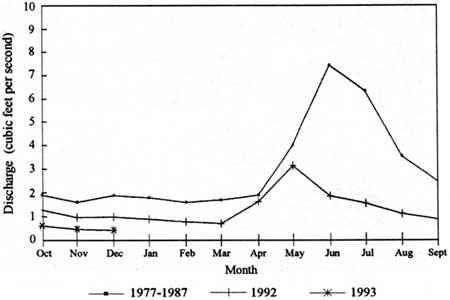|
Volume XXIV - 1993
Annie Spring Responds to Long-term Drought and Municipal Water Use
by Mark Buktenica
Crater Lake National Park has recently experienced one of the most
significant droughts in recorded history. The total precipitation of the
past three water years is the lowest three-year sum since records began
at Park Headquarters in 1931. Surface elevation of the lake itself has
cropped from 6,178 feet in 1984 to less than 6,168 feet in 1992.
Water for park municipal use is drawn from Annie Spring, the
headwaters of Annie Creek. The U.S. Geological Survey has maintained a
gauging station on Annie Creek since 1977, shortly after the park moved
its water intake facility from Munson Spring to Annie Spring. The
gauging station is located directly beneath the road crossing several
hundred feet belong Annie Spring. Although the water intake is located
at the spring origin, there are no discharge data for this site. The
origin is not the creek's sole source of water, as stream discharge
increases several fold between the spring and the road crossing.
Nevertheless, discharge data is taken at the gauging station in cfs
(cubic feet of water per second) during the water year, which runs from
October 1 to September 30.
During the winter of 1993, Annie Creek discharge is expected to drop
to its lowest level in the 16 year period for which records have been
kept. A typical hydrograph, or flow pattern, for the creek shows flow
decreasing through the fall and winter, reaching minimum values in March
or April (see chart). Spring flow responds rapidly to snow melt
increasing in April or May and peaking in June. Estimated flow values
for December 1992 (.43 cfs) are 23% of the 1977-1987 mean for December
(1.9 cfs). Discharge values for 1977 through 1991 are adjusted to
include water withdrawal from the spring. Values for 1992 and 1993
represent gauge recordings plus estimated water withdrawal rates based
on preliminary data analysis.
Although discharge is currently low, this is not the first time low
flows have been recorded. Minimum gauge values of .41 cfs end .39 cfs
were recorded on March 18, 1989, and April 29,1991, respectively. No
water intake problems were noted during 1989 and 1991. Municipal water
withdrawal has increased from approximately nine million gallons in 1990
to over 13 million gallons in 1992, compounding trends in reduced spring
discharge. Water use increased in each of the three developed areas that
withdraw water from Annie Spring (Munson Valley, Rim Village, and Mazama
Village). There were no dramatic increases in water use in Munson
Valley, Rim Village and Mazama Village during fall and winter 1990-1992.
Mazama Village was open, however, for the first time during the months
of November and December in 1992. The most dramatic seasonal increases
in water use occurred in Mazama Village and Munson Valley in June, July,
and August. Water use increased in Mazama Village from approximately
500,000 gallons in July, 1990, to 1,100,000 gallons in July, 1992. In
Munson Valley water use increased from approximately 370,000 gallons in
August 1990, to 990,000 gallons in August 1992. There is a trend toward
increased water use during the winter months. This trend is expected to
continue during the winter of 1993 (without water conservation) as
Sleepy Hollow housing area at Park Headquarters is near full
occupancy.
Accumulated snow fall as of January 12,1993, was above the long-term
average for that date. If snow fall trends continue, Annie Spring will
recharge and attain average or higher flow rates corresponding closely
in time with snow melt. The timing of snow melt, however, can only be
approximated
In summary, during the winter of 1993, Annie Spring will likely
reach the lowest recorded discharge values since the gauge was installed
in 1977. Compounding this problem is increased municipal water use and
water withdrawal from the spring. The creek appears to have adequate
flow to meet water demands, though the current catchment and withdrawal
system is probably not adequate to capture enough flow if current water
use and spring flow trends continue. The design of the water system
obviously warrants re-visiting, especially with more park development
proposed and increased visitor use projected. In light of this new
information, it is advisable to make new projections of future water use
to determine if Annie Spring can support water withdrawal projections
without violating water right allocations or instream flow requirements
for channel processes and stream biota.
Annie Creek
Mean Monthly Discharge (cfs)
By Water Year

|

